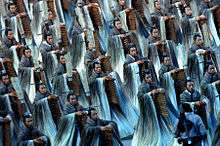2008 Summer Olympics opening ceremony
 Fireworks during the opening ceremony | |
| Time | 20:00 – 00:09 CST (UTC+8) |
|---|---|
| Date | 8 August 2008 |
| Location | Beijing, China |
| Coordinates | 39°59′30″N 116°23′26″E / 39.99167°N 116.39056°ECoordinates: 39°59′30″N 116°23′26″E / 39.99167°N 116.39056°E |
| Part of a series on |
|
|
The 2008 Summer Olympics opening ceremony was held at the Beijing National Stadium, also known as the Bird's Nest. It began at 20:00 China Standard Time (UTC+8) on Friday, 8 August 2008, as the number 8 is considered to be auspicious.[1][2][3][4][5] The number 8[6] is associated with prosperity and confidence in Chinese culture.[6] The artistic part of the ceremony comprised two parts titled "Brilliant Civilization" and "Glorious Era" respectively.[7] The first part highlighted the Chinese civilization and the second part exhibited modern China and its dream of harmony between the people of the world.[7] The stadium was full to its 91,000 capacity according to organizers.[8]
The ceremony was directed by Chinese filmmaker Zhang Yimou, who was the chief director and was assisted by Chinese choreographers Zhang Jigang and Chen Weiya.[9] The director of music for the ceremony was composer Chen Qigang.[9][10][11] It was noted for its focus on ancient Chinese culture, and for its creativity, as well as being the first to use weather modification technology to prevent rainfall.[12] The final ascent to the torch featured Olympic gymnast Li Ning, who appeared to run through air around the membrane of the stadium. Featuring 15,000 performers, the ceremony lasted over four hours and was reported to have cost over US$100 million to produce.[13] The opening ceremony was lauded by spectators and various international presses as spectacular and spellbinding and by many accounts "the greatest ever".[14]
Attending heads of state
More than 100 heads of state, heads of government and sovereigns attended the opening ceremony.[15][16] The number of heads of state who attended the opening ceremony was by far the largest in Olympic history.[17][18][19]
Sequence of events

Countdown
Welcoming ceremony began by a flame and an ancient Chinese sundial, awakened by the light of time from the sky, lights up 2008 bronze Fou drums. The drums, running like a time machine, form giant digits (in both Arabic and Chinese numerals) to count down the final seconds to the Games.
Welcoming ceremony – The Song-Fou
The 2008 drummers play the bronze Fou drums and sing the quote from The Analects of Confucius written 2000 years ago: "Isn’t it delightful to have friends coming from afar?” to welcome friends from all over the world.
Footprints of History and Olympic Rings
The firework footprints were set off at the rate of one every second; each represented one of the 29 Olympiads, signifying the Beijing Olympics as the XXIX Olympiad of the modern era. The 29th footprint arrived at Bird's Nest and transformed into Star Olympic Rings. Next, the rings were lift up by twenty "Dunhuang fairies" (Buddhist apsaras of the Mogao Caves).
National flag-raising ceremony
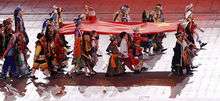
Attention was then turned to 56 young children representing the 56 ethnic groups of modern China, and donning respective costumes. They marched in the flag of the People's Republic of China as a young girl in red, 9-year-old Lin Miaoke (林妙可 Lín Miàokě), was seen performing "Ode to the Motherland", while miming to the voice of Yang Peiyi.[21] Only one-third of "Ode to the Motherland" was sung, to save time. The flag of the People's Republic of China was then handed over to eight well-dressed People's Liberation Army soldiers who carried the flag in a slow, goose-stepping march over to the flag podium and the Chinese national anthem "March of the Volunteers" was sung by a 224-member choir while the flag was raised.
Artistic section
The Artistic section tells about China's history and art.
- Includes the historic scroll painting
- And the bamboo books and bird
1. Scroll Painting
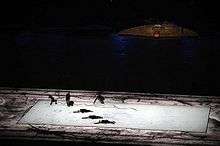
At the prelude to the section, Beautiful Olympics, a short film, was screened depicting the making of paper, another of the Four Great Inventions, ending with a rolled-up scroll painting to set the stage for the next segment. Ceramics, porcelain vessels and other Chinese fine arts artifacts were beamed on a giant LED scroll, representing the first of the Four Great Inventions of China, paper, and displaying animated graphics, slowly unfurling. At its center was a piece of white canvas paper, which then ushered in a performance of black-costumed dancers whose hands hid brushes that had been dipped in ink. They performed a dance while leaving their trails on the block of white paper, reminiscent of Chinese ink and wash painting.[23] This was accompanied by the sounds of the guqin, China's ancient seven-string zither, as played by Chen Leiji (S: 陈雷激, T: 陳雷激, P: Chén Léijī). The LED scroll then showed an old, rare painting by Wang Ximeng.
2. Written character
The giant scroll was then moved aside to show a fluid array 897 movable type blocks that formed three variations of the character 和 (Hé "harmony"), representing the third great Chinese invention: the movable type press. The character was shown, consecutively, in bronze inscription, Seal script and KaisScript (Modern Chinese script). Performers in Zhou-era clothing representing the "3000 Disciples of Confucius", carrying bamboo slips, recited excerpts from the Analects: "Isn't it great to have friends coming from afar?" (有朋自遠方來,不亦樂乎) and "All men are brothers within the Four Seas" (四海之內,皆兄弟也). The blocks changed into a small version of the Great Wall, which then sprouted peach blossoms, the Chinese symbol for openness.[24][25] At the end of the sequence the tops of the movable type blocks came off to reveal 897 performers, who waved vigorously to the crowds, indicating that the individual pieces of type block were not computer controlled and synchronized, but rather the combined efforts of 897 perfectly in-sync performers.
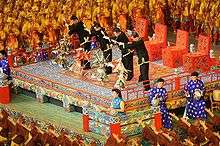
3. Opera
The next segment saw ancient terracotta soldiers and Chinese opera,[26] followed by a Beijing opera puppetry performance. The Wusheng type of Beijing opera performers was also enacted.
4. Silk Road
A Dunhuang fairy dances on the paper—which has become golden desert under the projection,held by hundreds of men in clothing of ancient diplomatic envoys. On the giant scroll is a depiction of ancient Silk Road on the land.. This was followed by a procession of men, in blue costumes, who with huge oars formed formations of junks, symbolizing the expeditions of Zheng He. A performer holding another great Chinese invention, the compass, in its ancient form a metal spoon floating in a fluid suspensible vessel, danced in the center of the giant LED scroll that showed images of sailing junks and maps of Zheng He's seven voyages on Maritime Silk Road in the Ming Dynasty.
5. Li and Yue (Ritual and Music)
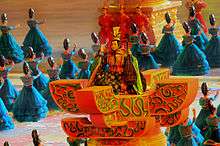

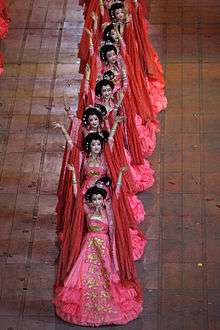
The segment represents the prosperity of ancient China as “The State of Li and Yue”. Accompanied by the music of Kunqu, one of the oldest extant Chinese operas, the giant scroll expands and shows several beautiful classic ancient paintings from Tang, Song, Yuan, Ming and Qing Dynasties. At this point, two rows of huge royal dragon pillars called huabiao (S: 华表, T: 華表, P: Huábiǎo) emerged and stretched skyward, with the performers dancing to the ancient tune Chūnjiāng Huā Yuèyè (春江花月夜), as pink and orange fireworks were set off overhead.
6. Starlight
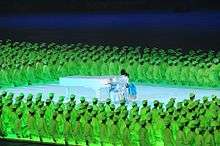
Then followed the modern segment where pianist Lang Lang and five-year-old Li Muzi[27] performed a melody from the Yellow River Cantata. Around the pianists a sea of rainbow-coloured luminescent performers swayed in wave-like unison to suggest the flow of the Yellow River. The illuminated performers, symbolizing modern-day China, then arranged themselves in the shape of the Dove of Peace, which wings were then set into motion as the performers moved about. They formed the bird's nest shape of the Beijing National Stadium. When a young girl flew a kite – also a Chinese invention – above them in mid-air, the performers' lights flickered in an intricate pattern.
7. Nature
A Tàijíquán performance by 2,008 masters[28] showed the fluid movements achieved when in harmony with nature. They demonstrated martial arts while combining to form geometric mass human formations. A skit was shown with schoolchildren drawing and coloring on the paper scroll and chanting poetry. These were the same children representing the 56 ethnic groups of China. They symbolized a Green Olympics (to protect the world). As their sequence drew to an end, the giant white paper was lifted vertically to reveal a drawing of mountains and waters with a smiling face as the sun. Then, there was a light presentation showing brightly coloured flying birds, symbolizing the rebirth of the phoenix and the bird-nest stadium itself.
8. Dream
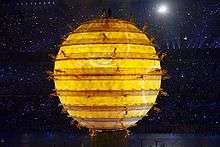
The next segment was a celestial show and the arrival of astronauts symbolizing Chinese space exploration, with a gigantic, 60-foot, 16-tonned[26] ball structure representing the earth. 58 acrobats tumbled rightside up, sideways or upside down on its surface, which was then transformed into a giant glowing Chinese lantern.
9. Theme song
Chinese singer Liu Huan and British singer Sarah Brightman stood on the central platform and sang the 2008 Olympic theme song: "You and Me" with international foreign countries global under 204 countries of region of around the world.[25]
2,008 performers then held out parasols with smiling faces of young children.[29] This was followed by red and orange fireworks in the form of smiley faces. The representatives from the 56 ethnic groups danced a vigorous folk dance.
Parade of nations
The athletes taking part in the 29th Olympiad parade of nations marched out to the centre of the stadium.
In accordance with Olympic tradition, the national team of Greece, which hosted the last Summer Olympics, in Athens, entered first, in honor of Greece's status as the birthplace of the Olympics, while the host country came last. Traditionally nations are ordered in alphabetic order of the national language of the host country (or if there is more than one, the more dominant of the languages of the host city); as Chinese writing is not alphabetic, the teams paraded by stroke order of the first character of their respective countries' names in Simplified Chinese.[4]
Countries with the same number of strokes in the first character are sorted by the order of the five basic strokes in Chinese characters (一,丨,丿,丶 and 乙). If the name of two or more countries has the same first character, then they are ordered according to the stroke order of the second character. For example, Latvia (Chinese: 拉脱维亚), Great Britain (Chinese: 英国), and British Virgin Islands (Chinese: 英属维尔京群岛) were the 114th, 115th and 116th to enter respectively while the first characters of their names are all eight strokes. However, the stroke order of Latvia's first character (拉) is 一丨一丶一丶丿一 while that of Great Britain is 一丨丨丨乙一丿丶. Latvia's third stroke (一) is before that of Great Britain (丨), which gave Latvia precedence to Great Britain. Great Britain and the British Virgin Islands share the same first character, 英. However the second one in Great Britain's name is 国, which has 8 strokes, while the second in British Virgin Islands is 属, which has 12 strokes. Thus Great Britain entered before British Virgin Islands. Guinea (Chinese: 几内亚) was the second country to enter following Greece as it only takes two strokes to write the first character in the country's name (几). Australia (Chinese: 澳大利亚) marched 202nd, just ahead of Zambia (Chinese: 赞比亚), which was the last country to march before China.[30] The first characters of these countries' names (澳 and 赞) are written with 15 and 16 strokes respectively.
Announcers in the stadium read off the names of the marching nations in French, English (the official languages of the Olympics), and Standard Chinese with music accompanying the athletes as they marched into the stadium. The leading signs of delegations, carried by young Chinese women in red dresses, had their names printed in these three languages: the Chinese version in traditional Chinese calligraphy; and above it in the other two languages, using a Roman alphabetic typeface that mimicked brush calligraphy. Chinese names of most states were condensed to their short forms when possible. For example, Bosnia and Herzegovina (波斯尼亚和黑塞哥维那) entered as 波黑 Bohei in Chinese, while Saudi Arabia (沙特阿拉伯) entered as simply 沙特 Shate. The exception was the Former Yugoslav Republic of Macedonia, which entered in Chinese as its full designation (前南斯拉夫马其顿共和国) because of the Macedonia naming dispute. China entered as People's Republic of China/République populaire de Chine in English and French, but simply as 中国 Zhongguo in Chinese, the most common short name. However, there are some exceptions. 印度尼西亚 (Indonesia) was used instead of 印尼, 马来西亚 (Malaysia) was used instead of 马国 and 卡塔尔 (Qatar) was used instead of 卡达.
The athletes marched along the tracks toward the center of the stadium, which was encircled by white-capped Chinese cheerleaders welcoming each contingent. As they did so, they would step on colored ink before treading on the Chinese painting done earlier by the children and the performance artists.
Throughout the entire Parade of Nations, the Olympic athletes were treated to live traditional music ensembles, hand-picked by the Chinese Olympic committee from around the world. Each ensemble represented a continent from the five Olympic rings. The groups included Chinese orchestra, Scottish bagpipers Mains of Fintry Pipe Band (Fintry Pipe Band), Aboriginal musicians and dancers from Australia (William Barton),[31] South African drummers (Drum Cafe),[32] and North American mariachi group Mariachi Mujer 2000.[33]
Unlike in previous years, North and South Korea did not send a unified team; their athletes marched in separately as Republic of Korea (South Korea, Chinese: 韩国) and the Democratic People's Republic of Korea (North Korea, Chinese: 朝鲜民主主义人民共和国).[34] Taiwan marched under the name "Chinese Taipei" (Chinese: 中华台北; pinyin: Zhōnghuá Táiběi) as per a 1989 agreement and in the Olympics since then – and the Chinese media has followed suit, referring to Taiwan as Zhonghua Taibei instead of the previously used and controversial Zhongguo Taibei (Chinese: 中国台北; pinyin: Zhōngguó Táiběi, literally "Taipei, China").[35][36]
The Chinese contingent, which was last, was led by Yao Ming and Lin Hao, the 9-year-old primary school student who had rescued two schoolmates during the 2008 Sichuan earthquake.[37][38]
Speeches by the presidents
Liu Qi, the head of the Beijing Olympic Organizing Committee, gave a speech in Mandarin welcoming the athletes. His Excellency Count Rogge, the President of the International Olympic Committee, followed with a speech in English, praising the Chinese for their warm reception and effort. The Count urged the athletes to "have fun" and to reject doping and performance enhancement drugs. This reminder was reiterated in French. Afterward, Hu Jintao, the President of the People's Republic of China, formally announced the opening of the 2008 Summer Olympics by speaking in Mandarin:
On behalf of the 29th Olympiad, I officially declare these Olympic Games of Beijing ... open.
Afterward, the Olympic flag was carried in by eight former athletes from China. They were:
- Zhang Xielin (table tennis)
- Pan Duo (Everest mountaineer)
- Zheng Fengrong (athletics)
- Yang Yang (A) (short-track speed skating)
- Yang Ling (shooting)
- Mu Xiangxiong (swimming)
- Xiong Ni (diving)
- Li Lingwei (badminton)
They then passed on the flag to the soldiers of the People's Liberation Army (the PLA) and the Olympic anthem played while the flag was being raised. A multinational chorus of 80 children sang the Olympic anthem in Greek. Chinese table tennis champion Zhang Yining and arbiter Huang Liping took the Olympic oath, representing athletes and officials respectively.
There was a short dance presentation, followed by bright yellow fireworks – representing the release of doves of peace.
Torch relay and the lighting of the flame cauldron
At this point, the Olympic flame entered the stadium as a continuation of the Beijing relay leg from the outside. The Olympic torch was relayed around the stadium by seven athletes, and was finally passed on to Li Ning, the former Olympic gymnast champion, the eighth and final athlete.
The eight athletes were, in order:
- Xu Haifeng (shooting, China's first Olympic gold medalist in any event, 1984)
- Gao Min (diving, China's first repeat Olympic gold medalist in any event, 1988 and 1992)
- Li Xiaoshuang (gymnastics, China's first gymnastics all-around World Champion and Olympic gold medalist, 1992 and 1996)
- Zhan Xugang (weightlifting, China's first double Olympic gold medalist in weightlifting, 1996 and 2000)
- Zhang Jun (badminton, double Olympic gold medalist in mixed doubles badminton, 2000 and 2004)
- Chen Zhong (taekwondo, China's first and double taekwondo gold medalist, 2000 and 2004)
- Sun Jinfang (volleyball, member of team that won China's first major championship in a team sport)
- Li Ning (gymnastics, China's most decorated athlete at its first Olympics, 1984)
Li Ning, who was suspended by wires, then appeared to run horizontally along the walls of the stadium through to the Olympic cauldron, which at this moment was still not shown. As he ran along the upper wall of the stadium, the projection displayed a scroll opening ahead of him, on which was beamed footage of previous torch relays around the world. At the final moment, a spotlight revealed the final resting place of the Olympic flame, which had appeared during the torch run. A colossal torch situated at the top of the stadium was lit by a proportionately large fuse.[40]
A flurry of spectacular fireworks of various colours and shapes, some projecting Olympic rings, others forming hoops, flower outwards, fountain or float down, accompanied the ending of the ceremony. The ceremony ended at 12:09 am, 9 August 2008 CST, which was later than the time originally planned: 11:30 pm, 8 August.
Encore
As the audience started to exit the stadium, singers from Mainland China and Hong Kong came onto the stage to provide music as a way to stall the audience from leaving all at once. Jackie Chan, Karen Mok, Han Hong, and Sun Nan (孙楠) sang the first song, "Stand Up", while Andy Lau, Nicolas Tse, Joey Yung, Wakin Chau, Wang Feng, and Sun Yue sang the second song, "Cheering for Life". Since the ceremony was already over time by then, this portion was not televised.[41]
Creative team
The creative team for the opening and closing ceremonies of the Beijing 2008 Olympic and Paralympic Games consisted of a roster of renowned individuals. The artistic performance of the Opening Ceremony, titled the "Beautiful Olympics", had the internationally acclaimed filmmaker Zhang Yimou as General Director, and Zhang Jigang and Chen Weiya as Deputy General Directors. Its core planning team comprised some of the best artists and technology experts in the world, including Yu Jianping, Lu Jiankang, Cai Guoqiang, Chen Qigang, British stagecraft designer Mark Fisher, Chen Yan, Sha Xiaolang, Japanese designer Eiko Ishioka, Xu Jiahua, Cheng Xiaodong, and Tan Dun.
In 2006, the Beijing Organizing Committee (BOCOG) initially chose American filmmaker Steven Spielberg, Yves Pepin, head of the French entertainment group ECA2, and Sydney Games opening ceremony director Ric Birch as special consultants.[42]
After working in collaboration with Artistic Director Zhang Yimou on his original creative and production proposal to BOCOG, David Zolkwer, Project Director for the Athens 2004 Olympic Games ceremonies was formally commissioned to provide ongoing Creative and Production consultancy for the Opening Ceremony directly to BOCOG along with colleagues Mik Auckland (Technical) and Celia Smith (Production) – all of whom worked for Jack Morton Worldwide at the time.
In February 2008, Spielberg pulled out of his role as advisor in protest over China's alleged continuing support of the Sudanese government and the ongoing violence in the Darfur region.[43] American composer Quincy Jones offered to write a theme tune for the 2008 Beijing Olympics and decided to stay on and contribute to the Beijing Olympics.[44] Chinese filmmaker Ang Lee was also part of the team creating the opening and closing ceremonies of the Games.[45]
Gillian Chung was originally scheduled to be a performer at the opening ceremony, but due to the Edison Chen photo scandal, director Zhang Yimou replaced her and her partner, Charlene Choi (not involved in the photo incident) with PRC C-pop act A-One.[46] A-One was not a part of the performances on 8 August.
Incidents and controversies
Accident during rehearsal
Liu Yan, one of China’s top classical Chinese dancers, fell from a three-metre high platform during practice on 27 July 2008 and sustained severe spinal injuries. She was paralyzed waist-down after a six-hour operation. Despite her not performing in the ceremony proper, deputy director Zhang Jigang ensured Liu's name was written in the programme as the lead dancer.[47]
In an interview after visiting Liu Yan in the hospital, Director Zhang Yimou said, "I feel sorry for Liu Yan, my heart is full of regrets, I’m deeply sorry. Liu Yan is a heroine. She sacrificed a lot for the Olympics, for me, for the opening ceremony." Shortly after the opening ceremony, in an earlier media interview, Zhang expressed: "I regret many things, many details of this performance, many things I could have done better. For example, there are performers who were injured. I blame myself for that."[48]
Rehearsal leakage
The South Korean Seoul Broadcasting System (SBS) secretly filmed rehearsals of the opening ceremony and leaked parts of it, violating a prohibition by the Organizing Committee.[49] The video was uploaded at YouTube on 30 July 2008, but was deleted soon after its upload. However, several additional videos have been uploaded by other users.[50] The Organizing Committee investigated the unauthorized filming,[51] and on 6 August 2008, banned SBS cameras inside the stadium during the ceremony as reprisals for the leak.[52]
Girl lip-synching to recording by another singer
The song "Ode to the Motherland" appeared to be sung by Lin Miaoke at the ceremony, but it emerged she had mimed her performance to a recording by another girl, Yang Peiyi. It was a last-minute decision to use lip-synching, following a Politburo member's objection to Lin's voice.[21][53][54][55] International Olympic Committee executive director Gilbert Felli defended the use of a more photogenic double.[56][57] Although the names of both Lin Miaoke and Yang Peiyi appeared in the programme notes,[58] the vast majority who watched the broadcast did not realise Yang Peiyi's role until several days later when music director Chen Qigang acknowledged it.
Performers at previous Olympic opening ceremonies had occasionally synched to recordings of their own performance, such as the tenor Luciano Pavarotti at the 2006 Winter Olympics in Turin, due to his pancreatic cancer.[59] Then nine-year-old Eleonora Benetti also lip-synched to a previous recording of the Italian National Anthem.[60] The Sydney Symphony Orchestra appeared to perform at the 2000 Summer Olympics in Sydney, but the music spectators heard was entirely pre-recorded, with some of the music pre-recorded by the Melbourne Symphony Orchestra.[61]
Computer-simulated fireworks
Television coverage of the fireworks show which displayed the 29 firework "footprints" outside the stadium was simulated by computer animation.[62][63] Twenty-nine sets of fireworks in the shape of a footprint did actually go off,[62] but it was decided that it would be difficult and dangerous to get a good shot from helicopters capturing all 29 of the footsteps (which went off every two seconds), so a CGI of 27 of the footprints was made for television broadcasts, and only the last two were filmed live. The 55 seconds of display took the BOCOG a year to choreograph. The substitution of CGI footage was mentioned during the time-delayed U.S. broadcast of the ceremony on NBC by announcers Matt Lauer and Bob Costas.[59][64][65]
Children representing minority groups
On 15 August, Wang Wei, the vice president of the BOCOG, confirmed that children who appeared in the opening ceremony in the costumes of the 56 ethnic groups of modern China did not belong to the ethnic minorities their costumes indicated, as described in publicity materials, but instead all or most were members of the majority Han Chinese. Wang said it was "traditional" and not unusual for actors in China to wear different ethnic costumes.[66][67]
Reception
Count Rogge, President of the International Olympic Committee, described the ceremony as "spectacular" and an "unforgettable and moving ceremony that celebrated the imagination, originality and energy of the Beijing Games." He furthermore hailed the Beijing National Stadium as "one of the world's new wonders" and a "fitting setting for an amazing Opening Ceremony." Hein Verbruggen, IOC Member and Chairman of the Coordination Commission for the Games of the XXIX Olympiad, called the ceremony "a night to remember", "a breathtaking culmination of seven years of planning and preparation" and "an unprecedented and grand success" that exceeded all his expectations.[68]
The AFP called it "a spectacular opening ceremony."[69] The BBC and The Times concurred by calling it a dazzling and spectacular show in Beijing.[70][71] The Associated Press praised the show as spectacular with an extravaganza of pageantry and "interlude of fervor and magic" as well as being "spellbinding" and noted the show steered clear of modern politics.[72] The USA Today described it as an exhilarating display of China's thousands of years of traditions of art and culture,[73] and the Art Daily stated it was a celebration of China's ancient history, along with sumptuous costumes from different imperial dynasties.[74] Roger Ebert of the Chicago Sun-Times commented that "the scope, precision and beauty of the production was, you will agree, astonishing."[75] The Spanish media were impressed by the opening ceremony,[76] with Antena 3 describing the ceremony as "an astonishing effort," while Cuatro called it "awesome and impressive."[76] Cadena COPE said it was "the most dramatic Olympic opening ceremony ever."[76] Germany's Deutsche Welle also praised it as a spectacular and a firecracker of a show, and a trip through China's rich history.[77]
Steven Spielberg called the show "an unforgettable spectacle" and "arguably the grandest spectacle of the new millennium."[78] At the end of 2008, the American Film Institute selected the coverage of the 2008 Summer Olympics opening ceremony as one of their "Eight Moments of Significance" of the year of 2008, and states: "The opening ceremony, directed and staged by acclaimed Chinese filmmaker Zhang Yimou, marked the most significant live event of the year" and it described the opening ceremony as "staged with breathtaking poetry."[79]
World leaders were also impressed by the opening ceremony. U.S. President George W. Bush described the ceremony as "spectacular and successful".[80] Former British Prime Minister Tony Blair called it "the spectacular to end all spectaculars and probably can never be bettered."[81]
While praise for the opening ceremony was widespread amongst the world's media,[14] the Singaporean newspaper The Straits Times described some western media reactions as "cynical" and "hostile".[82] The Globe and Mail had a column with title "The iron hand behind the magic show",[83] some questioned the "heavy military theme".[84] Asia Times, although praising the show as "stunning opening ceremony ... with its panoply of color, painstaking choreography and sweeping portrait of Chinese culture and history" referred to the games as one devoid of "fun" in its article headlined "Awe (but no laughter) in Beijing".[85]
Television
Estimates of the global television audience varied: "around one billion" (Reuters);[86] "experts estimated ... more than two billion" (Wall Street Journal);[87] "2.3 billion" (MindShare);[88] "Billions ... probably the largest live television audience in history" (Bloomberg);[89] "3 billion" (Sky News);[90] "nearly 4 billion" (Xinhua);[91] "as many as 4 billion" (Washington Post);[92] "estimated 4 billion" (McClatchy).[93] This included an estimated 842 million viewers watching on host Chinese broadcaster China Central Television (CCTV), with polls ranging from 63 and 69 percent of the Chinese viewing population, exceeding that of the 51–58 percent who watch the network's annual Chinese New Year gala.[86]
The BBC reported five million viewers in the United Kingdom, the Seven Network had 7.8 million viewers in Australia, The Hollywood Reporter said 4.4 million in France watched the ceremony, the ARD estimated 7.72 million viewers in Germany, while in Italy, RAI had 5.5 million viewers, and in Spain, TVE obtained 4 million viewers. In the United States, the NBC network delayed its telecast by 12 hours for evening primetime viewing, though Americans in markets bordering Canada could watch it on CBC Television, and others watched clips of it earlier on YouTube and other online video websites.[94] Still, it managed to capture an average of 34.2 million viewers[95][96] and a total of 69.9 million viewers.[65] The ceremony, therefore, became the most watched Olympic Opening Ceremony ever held in a non-U.S. city by American audience,[96] a record previously held by the Lillehammer Games of 1994.[95] It was the biggest television event in the U.S. in 2008 since the Super Bowl, and it also surpassed the ratings for the 2008 Academy Awards ceremony and that year's finale of American Idol.[96]
In the United States, NBC concluded its broadcast with a message saying that their coverage of the opening ceremony was dedicated in memory of Jim McKay, longtime Olympics broadcaster with rival ABC, who died on 7 June.[97][98] ABC "loaned" McKay to NBC to serve as a special correspondent during their coverage of the Salt Lake City Olympics.[99]
See also
![]() Media related to 2008 Summer Olympics opening ceremony at Wikimedia Commons
Media related to 2008 Summer Olympics opening ceremony at Wikimedia Commons
- 2008 Summer Olympics closing ceremony
- 2008 Summer Olympics national flag bearers
- Four Great Inventions
References
- ↑ "Tickets Information – The official ticketing website of the BEIJING 2008 Olympic Games". Retrieved 21 August 2009.
- ↑ "Beijing Confirms the Opening Ceremony Time for 2008 Olympics" Archived 9 August 2008 at the Wayback Machine., Travel China Guide. Retrieved 2 August 2008.
- ↑ "Photo: Opening ceremony sample ticket". Official website. 2008-04-23. Retrieved 21 August 2009.
- 1 2 "Opening Ceremony plan released". Official website. 2008-08-06. Archived from the original on 8 August 2008. Retrieved 6 December 2013.
- ↑ "Beijing 2008 As the final seconds ticked away". Omega, official timekeeper. Retrieved 21 August 2009.
- 1 2 "The Number Eight And The Chinese". Archived from the original on 27 April 2007. Retrieved 6 December 2013.
- 1 2 "How the Opening Ceremony was born". The Beijing Organizing Committee for the Games of the XXIX Olympiad. 2008.
- ↑ Bristow, Michael (2008-08-09). "Spectators awed as Games begin". BBC News. Archived from the original on 1 June 2013. Retrieved 6 December 2013.
- 1 2 Zhang Yimou and his five creative generals Archived 28 April 2009 at the Wayback Machine.
- ↑ "How the Opening Ceremony was born". Retrieved 21 August 2009.
- ↑ "Behind the 29th Olympic Opening Ceremony". radio86.co.uk. Retrieved 21 August 2009.
- ↑ Xinhua (9 August 2008). "Beijing disperses rain to dry Olympic night". Chinaview.cn. Retrieved 21 August 2009.
- ↑ Brand, Madeleine; Berkes, Howard (8 August 2008). "China Celebrates Opening Of Summer Olympics". NPR. Retrieved 18 September 2015.
- 1 2 "Press hails 'greatest ever' Olympic opening show". Agence France-Presse. 2008-08-09. Retrieved 9 August 2008.
- ↑ "Emotion kicks off China's Olympics". CNN. 2008-08-09. Retrieved 21 August 2009.
- ↑ "FACTBOX: World leaders to attend Olympics opening in Beijing". Reuters. 2008-08-06. Retrieved 21 August 2009.
- ↑ http://english.people.com.cn/90001/90776/90883/6466194.html
- ↑ http://news.xinhuanet.com/english/2008-08/07/content_9033271.htm
- ↑ "Beijing lifts air quality goal for games" Archived 4 May 2008 at the Wayback Machine., World News Australia
- ↑ Santo Tomas, Jojo (2008-08-09). "2008 Olympics get under way: Judoka Ric Blas Jr. chosen as flagbearer". Pacific Daily News. Retrieved 8 August 2008.
- 1 2 Yardley, Jim (13 August 2008). "In Grand Olympic Show, Some Sleight of Voice". The New York Times. Retrieved 13 August 2008.
- ↑ "Opening Ceremony 2008 Olympics, Beijing". Department of Defense Photo Essay. U.S. Department of Defense.
- ↑ "Feature: Chinese culture shines at dazzling Olympics opening ceremony". Xinhua. 2008-08-09. Retrieved 21 August 2009.
- ↑ Birch, Ric (17 August 2008). "How the Opening Ceremony went like a dream". Sunday Herald Sun. Retrieved 17 March 2010.
- 1 2 Macartney, Jane (9 August 2008). "Olympics: the power and the glory – China leaves world awestruck". Times of London. Retrieved 21 August 2009.
- 1 2 "Beijing dazzles: Chinese history, athletes on parade as Olympics begin". CBC Sports. 8 August 2008. Retrieved 21 August 2009.
- ↑ Lang delights the crowd with moving performance Chen Jie, China Daily Staff Writer.
- ↑ Art performance of Beijing Olympics opening ceremony showcases Chinese culture www.chinaview.cn, 2008-08-08
- ↑ Most of the smiling photos are collected by MERRY PROJECT.
- ↑ "Olympics athletes march to be done to different drum". ABC Radio Australia. 29 July 2008. Retrieved 21 August 2009.
- ↑ williambarton.com.au
- ↑ drumcafe.com
- ↑ mariachimujer2000.com
- ↑ Tedmanson, Sophie (8 August 2008). "North and South Korea to march separately in Olympics opening ceremony". Times of London. Retrieved 9 August 2008.
- ↑ Hsiu-Chuan, Shih; Shu-Ling, Ko (25 July 2008). "Taiwan's Olympic title fuels controversy". Taipei Times. Archived from the original on 9 August 2008. Retrieved 9 August 2008.
- ↑ Cazeneuve, Brian (8 August 2008). "China makes its opening statement". CNN. Archived from the original on 15 September 2008. Retrieved 9 August 2008.
- ↑ "Yao Ming and boy from quake zone lead Team China into opening ceremony". Retrieved 21 August 2009.
- ↑ Hughes, Mary (9 August 2008). "Beijing's Opening Ceremony Finds a Hero". Most Valuable Network, MA. Retrieved 21 August 2009.
- ↑ Chinese President Hu Jintao declares open Beijing Olympic Games Archived 9 August 2008 at the Wayback Machine.
- ↑ Former gymnast Li Ning lights Olympic cauldron Archived 9 August 2008 at the Wayback Machine.
- ↑ 華仔鳥巢獻唱 港人無眼福 祖兒見證奧運開幕 感動想喊 Archived 14 August 2008 at the Wayback Machine., Sing Tao Daily. 2008-08-10.
- ↑ "Zhang Yimou to direct opening ceremony of Beijing Olympics". Chinadaily. 17 April 2006. Retrieved 4 July 2008.
- ↑ Abramowitz, Rachel (18 February 2008). "Spielberg drops out as Beijing Olympics advisor". Los Angeles Times. Archived from the original on 3 June 2008. Retrieved 13 February 2007.
- ↑ Daunt, Tina (19 August 2008). "Quincy Jones stays with Beijing Summer Olympics". Los Angeles Times. Retrieved 21 August 2009.
- ↑ "Ang Lee joins Olympic directing team". The Guardian. London. 17 October 2006. Retrieved 21 August 2009.
- ↑ "Dirty downloads: diva axed from Olympic ceremony". Sydney Morning Herald. 26 February 2008. Retrieved 21 July 2008.
- ↑ Jin, Wu; Xiaoying, Hou (13 August 2008). "Tragedy of paralyzed Olympic dancer". China.org.cn. Retrieved 21 August 2009.
- ↑ Barboza, David (15 August 2008). "Behind the Opening Ceremony, a Paralyzing Fall". New York Times. Retrieved 17 March 2010.
- ↑ "Beijing opening ceremony leaked". Sydney Morning Herald. 31 July 2008. Retrieved 21 August 2009.
- ↑ "韩媒曝光北京奥运开幕式细节遭网友谴责 (Beijing Olympic Games opening ceremony details made public)". Retrieved 21 August 2009.
- ↑ "Defiant China hits out at US, stands firm on Internet censorship". 31 July 2008. Retrieved 21 August 2009.
- ↑ "Broadcaster banned for Olympic breach". NBC News. Associated Press. 6 August 2008. Retrieved 21 August 2009.
- ↑ Spencer, Richard (12 August 2008). "Beijing Olympics: Faking scandal over girl who 'sang' in opening ceremony". The Telegraph. London. Retrieved 21 August 2009.
- ↑ The radio interview of the music director Chen Qigang on YouTube
- ↑ Bristow, Michael (2008-08-12). "China Olympic ceremony star mimed". BBC News. Retrieved 21 August 2009.
- ↑ Agence France-Presse (13 August 2008). "Organisers defend fake ceremony singer". iol. Retrieved 5 October 2012.
- ↑ Agence France-Presse (13 August 2008). "Chinese media blackout on faked Olympic ceremony saga". AFP. Retrieved 5 October 2012.
- ↑ http://i1.hk/u/attachments/day_080818/20080818_6b737a87cd8ab18ee6c04o5Xf83WXwzl.jpg
- 1 2 Magnier, Mark (2008-08-13). "China abuzz over lip-syncing singer". Los Angeles Times. Retrieved 15 March 2010.
- ↑ Foster, Chris; Elliot, Helene; et al. (13 February 2006). "Injured Norstrom May Not Skate for Sweden". Los Angeles Times. Retrieved 21 August 2009.
- ↑ Jinman, Richard (26 August 2008). "Revealed: Sydney Olympics faked it too". Sydney Morning Herald. Retrieved 4 November 2009.
- 1 2 Spencer, Richard (2008-08-10). "Beijing Olympic 2008 opening ceremony giant firework footprints 'faked'". London: The Telegraph. Retrieved 21 August 2009.
- ↑ "Beijing enhanced Olympic show with faked 'fireworks'". CNN. 12 August 2008. Archived from the original on 22 August 2008. Retrieved 12 August 2008.
- ↑ "Part of Olympic display altered in broadcast". MSNBC. 2008-08-11. Retrieved 21 August 2009.
NBC broadcasters Matt Lauer and Bob Costas made mention of the alteration as it aired. 'You’re looking at a cinematic device employed by Zhang Yimou here,' Lauer said. 'This is actually almost animation. A footstep a second, 29 in all, to signify the 29 Olympiads.' Costas responded, 'We said earlier that aspects of this Opening Ceremony are almost like cinema in real time. Well this is quite literally cinematic.'
- 1 2 Folkenfilk, David (12 August 2008). "Live From Beijing: Computer-Enhanced Fireworks". NPR. Retrieved 21 August 2009.
- ↑ Spencer, Richard (2008-08-15). "Beijing Olympics: 'Ethnic' children exposed as fakes in opening ceremony". London: Daily Telegraph. Archived from the original on 21 August 2008. Retrieved 21 August 2008.
- ↑ "Minority ethnic groups used in Games' opening were fake". Irish Times. 16 August 2008.
- ↑ Verbruggen: Opening Ceremony a grand success Archived 28 April 2009 at the Wayback Machine.
- ↑ "Beijing's Games kick off with spectacular opening ceremony". AFP. 2008-08-08. Retrieved 9 August 2008.
- ↑ "Games begin with spectacular show". BBC. 2008-08-08. Archived from the original on 9 August 2008. Retrieved 9 August 2008.
- ↑ "Olympic Opening Ceremony spectacular sets the bar high for London 2012". Times of London. 9 August 2008.
- ↑ Crary, David (8 August 2008). "China opens its long-sought Olympics spectacularly". The Boston Globe. Associated Press. Retrieved 15 March 2010.
- ↑ Lloyd, Janice (2008-08-08). "China opens Olympics with fireworks, pageantry". USA Today. Retrieved 9 August 2008.
- ↑ "Chinese Director Zhang Yimou Presents Dazzling Opening Ceremony at The Olympic Games". Art Daily. 2008-08-08. Archived from the original on 9 August 2008. Retrieved 9 August 2008.
- ↑ Ebert, Roger (9 August 2008). "Zhang Yimou's gold medal". Chicago Sun-Times. Retrieved 21 August 2009.
- 1 2 3 "Spanish media impressed by Olympic opening ceremony". Earth Times. 2008-08-08. Retrieved 9 August 2008.
- ↑ "China opens its long-sought Olympics spectacularly". Deutsche Welle. 2008-08-08. Retrieved 21 August 2009.
- ↑ "Person Of The Year 2008". Time. 2008-12-17. Retrieved 21 August 2009.
- ↑ "AFI picks 'Moments of Significance'". The Hollywood Reporter. 2008-12-29. Retrieved 21 August 2009.
- ↑ "News Feature: Bush blends sports, politics at Beijing Olympics _English_Xinhua". Archived from the original on 16 September 2009. Retrieved 12 September 2009.
- ↑ "We Can Help China Embrace the Future – The Office Of Tony Blair". Archived from the original on 27 July 2009. Retrieved 25 July 2009.
- ↑ Ling, Wong Mei (9 August 2008). "Great show, but...". Singapore Straits Times. Retrieved 21 August 2009.
- ↑ Blatchford, Christie (9 August 2008). "Beware the iron hand behind the magic show". The Globe and Mail. p. A13.
- ↑ Beck, Lindsay (9 August 2008). "Olympic opening gala wins raves, raises questions". Reuters. Retrieved 15 March 2010.
- ↑ Ewing, Kent (12 August 2008). "Awe (but no laughter) in Beijing". Asia Daily. Retrieved 21 August 2009.
- 1 2 Goldsmith, Belinda (2008-08-11). "Beijing opening night lures 15 percent of world". Reuters. Archived from the original on 13 August 2008. Retrieved 11 August 2008.
- ↑ Dean, Jason; Fong, Mei (2008-08-09). "Opening Ceremonies Aim To Illustrate Rise to Global Power". Wall Street Journal. Archived from the original on 28 August 2008. Retrieved 11 August 2008.
- ↑ Sweney, Mark (2008-08-08). "Beijing Olympics: UK firm behind TV titles for China state broadcaster". The Guardian. London. Archived from the original on 9 August 2008. Retrieved 11 August 2008.
- ↑ Baynes, Dan (2008-08-08). "China's Hu Opens Beijing Games to Global Audience of Billions". Bloomberg. Retrieved 11 August 2008.
- ↑ Stone, Mark (2008-08-11). "Parts of the spectacular Beijing Olympics opening ceremony were faked, it has emerged.". Sky News. sky.com. Retrieved 11 August 2008.
- ↑ "Beijing Olympics opening ceremony hailed all over world". Xinhua. 2008-08-09. Archived from the original on 12 August 2008. Retrieved 11 August 2008.
- ↑ Cody, Edward; Fan, Maureen; Drew, Jill (9 August 2008). "A Spectacular Opening to the 29th Olympiad". Washington Post. Retrieved 15 March 2010.
- ↑ Kaufman, Michelle (2008-08-11). "Let the fireworks begin: China's Opening Ceremony dazzles 91,000 in hazy Bird's Nest". Kansas City Star. McClatchy. Retrieved 11 August 2008.
- ↑ Stelter, Brian (9 August 2008). "Tape Delay by NBC Faces End Run by Online Fans". New York Times. Retrieved 6 December 2013.
- 1 2 "32.6 million watch opening of Winter Olympics". NBC News. Associated Press. 13 February 2010. Archived from the original on 16 February 2010. Retrieved 27 March 2010.
- 1 2 3 Bauder, David (9 August 2008). "Opening night is a big TV draw for NBC". USA Today. Associated Press. Retrieved 6 December 2013.
- ↑ Olympics 2008 Opening Ceremony Intro and Ending **Courtesy of NBC** on YouTube
- ↑ Sandomir, Richard; Litsky, Frank (8 June 2008). "Jim McKay, ABC Sportscaster, Dies at 86". The New York Times. Retrieved 6 December 2013.
- ↑ 2002 Salt Lake City Opening Ceremonies – Intro on YouTube
